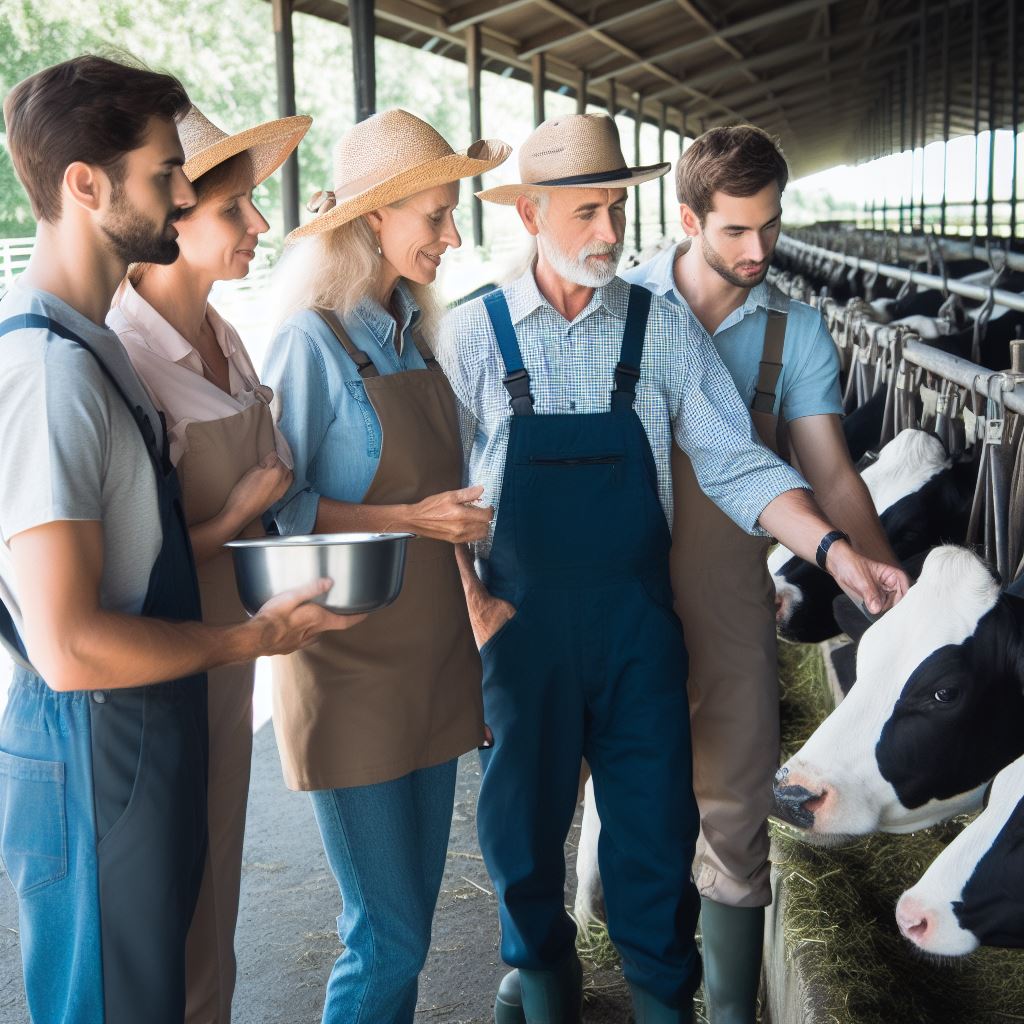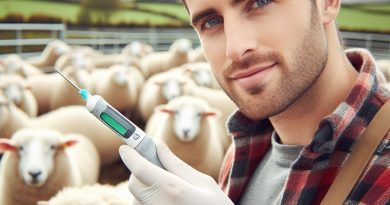Effective Dairy Farming: Yield Maximizing Tips
Last Updated on March 2, 2024
Introduction
Maximizing yield in dairy farming is crucial for profitability and sustainability.
Effective dairy farming practices ensure healthy cows and high-quality milk production.
The purpose of this blog post is to provide tips and strategies for maximizing dairy farming yield.
Introduction to Yield Maximization in Dairy Farming:
Dairy farmers worldwide face the crucial task of maximizing yields to ensure profitability and sustainability. The demand for high-quality dairy products emphasizes the need for efficient production.
Significance of Effective Dairy Farming Practices:
- Optimal Resource Utilization: Efficient practices ensure that resources like feed, water, and land are used effectively, minimizing waste.
- Healthy Herd Management: Implementing proper healthcare and nutrition practices ensures a robust and productive dairy herd.
- Quality Milk Production: Effective farming practices contribute to the production of high-quality milk with optimal levels of fat and protein.
- Economic Viability: Maximizing yields directly impacts the economic viability of dairy farming, enhancing the financial success of the enterprise.
Purpose of the Blog Post:
This blog post aims to guide dairy farmers on practical strategies for yield maximization.
By exploring effective farming practices, farmers can boost productivity, enhance herd health, and contribute to the overall success of their dairy operations. Stay tuned for actionable tips and insights in the upcoming sections!
Importance of Proper Nutrition
The role of balanced diets for dairy cows
- Proper nutrition is crucial for the overall health and productivity of dairy cows.
- A balanced diet ensures that cows receive all the necessary nutrients required for optimum performance.
- Absence of proper nutrition can lead to a decline in milk production and reproductive issues.
- Feeding cows a balanced diet helps maintain a healthy immune system, preventing diseases and infections.
The essential nutrients needed for maximum milk production
- Proteins are vital for building and repairing tissues and are essential for milk production.
- Carbohydrates provide energy to cows and aid in efficient milk production.
- Fats contribute to the overall energy reserves of cows and promote milk fat production.
- Vitamins and minerals play a crucial role in the cow’s metabolism and overall health.
Mention the benefits of using high-quality feed
- High-quality feed ensures that cows receive the necessary nutrients in the correct proportions.
- Good feed maximizes nutrient utilization, leading to increased milk production.
- It helps cows maintain a healthy body condition, enhancing their reproductive performance.
- Using high-quality feed minimizes the risk of nutrient deficiencies and imbalances.
- Cows fed with high-quality feed are less prone to stress and have better resistance to diseases.
In short, providing dairy cows with a balanced diet is of utmost importance for maximizing milk production.
A balanced diet ensures cows receive the necessary nutrients, promotes their overall health, and helps prevent various complications.
The essential nutrients such as proteins, carbohydrates, fats, vitamins, and minerals play significant roles in milk production.
Using high-quality feed further enhances the benefits, optimizing nutrient utilization and improving the cow’s general well-being.
Implementing proper nutrition practices is essential for dairy farmers aiming to maximize their farm’s productivity and profitability.
Read: Sustainable Tech in Agriculture: A New Era
Maintaining a Clean and Comfortable Environment
The significance of clean and well-ventilated barns
- Clean and well-ventilated barns promote optimal health for dairy cows and increase milk production.
- Proper ventilation reduces the risk of respiratory diseases and improves overall cow comfort.
- Good air quality prevents the buildup of harmful gases like ammonia, which can negatively impact cow health.
- A well-maintained barn also reduces the chances of bacterial and fungal growth, ensuring a safer environment for cows.
- Regular cleaning and disinfection of barns minimize the spread of diseases and enhance the herd’s overall productivity.
Proper manure management techniques
- Effective manure management is essential for maintaining a clean and healthy dairy farm environment.
- Implementing a comprehensive manure management plan helps minimize the environmental impact and odors associated with manure.
- Regular removal of manure from barns and storage areas reduces the risk of bacterial contamination and fly infestation.
- Proper storage and handling of manure prevent nutrient runoff, protecting local water sources from pollution.
- Utilizing manure as fertilizer can further benefit the farm by reducing the need for synthetic fertilizers and improving soil fertility.
The importance of regular bedding changes
- Regular bedding changes are crucial for ensuring cow comfort and preventing the spread of diseases.
- Comfortable bedding helps minimize instances of lameness and improves cow lying behavior, promoting better milk production.
- Clean bedding reduces the risk of mastitis, a common udder infection among dairy cows.
- Properly managed bedding also provides insulation, keeping the cows warm during colder months.
- Frequent bedding changes help maintain dry and hygienic conditions, enhancing the overall welfare of the herd.
In fact, maintaining a clean and comfortable environment on a dairy farm is vital for maximizing milk production and ensuring the well-being of the cows.
Clean and well-ventilated barns, along with proper manure management techniques, play a significant role in achieving these goals.
Regular bedding changes further contribute to cow comfort and overall health.
By prioritizing cleanliness, dairy farmers can create a conducive environment for their herd, resulting in improved productivity and better dairy farming outcomes.
Read: Agri-Drones: Changing the Face of Farming
Regular Health Monitoring and Veterinary Care
Importance of Regular Check-ups for Cows
- Regular check-ups are essential to ensure the overall health and wellbeing of dairy cows.
- Check-ups help identify and address any potential health issues before they become serious.
- Early detection of diseases or infections allows for timely intervention and better treatment outcomes.
- Veterinarians can assess the cows’ body condition, monitor their weight, and evaluate their reproductive health during check-ups.
- Regular check-ups also involve examining the teeth, hooves, and udders to detect any abnormalities or potential problems.
- By regularly monitoring the cows’ health, farmers can proactively prevent health issues and maximize their overall productivity.
Significance of Vaccinations and Preventive Treatments
- Vaccinations safeguard cows from various diseases and prevent the spread of contagious infections within the herd.
- Vaccines help to strengthen the cows’ immune system and increase their resistance to common diseases.
- Important vaccinations include those against diseases such as brucellosis, leptospirosis, and bovine viral diarrhea.
- By administering preventive treatments, such as deworming medications, farmers ensure optimal health for their cows.
- Preventive treatments help control internal and external parasites that can compromise the cows’ health and milk production.
- Regular vaccinations and preventive treatments reduce the risk of costly treatments and potential production losses.
Role of Prompt Disease Detection and Treatment in Maximizing Yield
- Early disease detection plays a crucial role in preventing the spread of diseases and minimizing their impact.
- Monitoring the cows closely helps identify subtle changes in behavior, appetite, or milk production that may indicate health issues.
- Prompt diagnosis and treatment of diseases significantly reduce the risk of complications and improve recovery chances.
- Effective treatment options can be implemented promptly, preventing the disease from adversely affecting the cow’s productivity.
- Regular health monitoring and veterinary care contribute to maintaining a healthy and high-yielding herd.
- Maximizing yield requires a proactive approach towards disease prevention, detection, and timely treatment.
In general, regular health monitoring and veterinary care are integral to effective dairy farming.
Through regular check-ups, farmers can detect and address health issues early on, ensuring the wellbeing of their cows.
Vaccinations and preventive treatments further protect the herd from diseases, minimizing the risk of production losses.
Additionally, promptly detecting and treating diseases maximizes the cows’ productivity and reduces the overall impact on the farm.
By prioritizing regular health monitoring and veterinary care, dairy farmers can optimize their yields and maintain a thriving dairy operation.

Proper Milking Techniques
Importance of Milking Frequency
Milking frequency plays a crucial role in dairy farming as it directly affects milk production and cow health.
- Regular milking sessions ensure efficient milk removal, preventing udder discomfort and potential infections.
- Maintaining a consistent milking schedule stimulates milk production and promotes healthy udder development.
- Increased milking frequency leads to higher milk yields as it stimulates the cow’s mammary glands to produce more milk.
- Proper milking frequency also aids in preventing milk accumulation, mastitis, and other udder-related issues.
Significance of Proper Milking Procedures
Adhering to proper milking procedures is essential for maintaining milk quality and cow well-being.
- Thoroughly cleaning and sanitizing the udder before milking reduces bacterial contamination in the milk.
- Gentle and correct teat preparation stimulates the cow’s let-down reflex, ensuring efficient milk flow.
- Using clean and dry hands, the milker must gently squeeze and strip each teat to check for abnormalities or mastitis symptoms.
- Proper attachment of milking equipment, such as milking clusters, prevents vacuum fluctuations and minimizes stress on the cow’s udder.
- Ensuring post-milking teat disinfection helps prevent the entrance of bacteria into the udder, reducing the risk of infections.
Benefits of Using Modern Milking Equipment
The use of modern milking equipment brings numerous advantages to dairy farmers.
- Efficiency and speed: Modern milking machines can significantly reduce milking time, allowing farmers to handle larger herds with ease.
- Improved milk quality: Advanced milking equipment ensures hygienic milk production by minimizing bacterial contamination.
- Enhanced cow comfort: Modern machines are designed to be more comfortable for cows, reducing stress during the milking process.
- Accurate milk measurement: Automated systems provide accurate milk yield data, aiding in monitoring cow health and productivity.
- Lower labor requirements: With automated milking machines, fewer workers are needed, saving time and labor costs.
- Reduced physical strain: Modern milking equipment is designed to minimize physical strain on milkers, promoting their well-being.
- Enhanced record-keeping: Some modern milking systems offer software that enables detailed record-keeping for individual cows, facilitating better farm management.
Implementing proper milking techniques, including maintaining appropriate milking frequency, following correct milking procedures, and utilizing modern milking equipment, maximizes milk yield and ensures the overall health and well-being of dairy cows.
By prioritizing these aspects, dairy farmers can optimize productivity, maintain high milk quality, and create a more efficient and profitable dairy farm.
Read: Vertical Farming: The Rise of Urban Agriculture
Uncover the Details: Winter Care for Sheep and Goats
Breeding and Genetics
The role of selective breeding in yield improvement
- Selective breeding plays a crucial role in enhancing the yield of dairy cows.
- Through careful selection, farmers can choose cows that possess desirable traits for maximum productivity.
- This process involves breeding cows with high milk production, strong immune systems, and good reproductive abilities.
- By focusing on these traits, farmers can gradually improve the overall yield of their dairy herd.
The use of genetic selection techniques for productive traits
- Genetic selection techniques have revolutionized dairy farming by allowing farmers to identify superior traits.
- With the help of genetic testing and advanced breeding methods, farmers can choose the best possible matches to achieve desired traits.
- This enables the selection of cows with improved milk yields, increased fertility, and resistance to diseases.
- By incorporating genetic selection techniques, dairy farmers can accelerate the breeding process and achieve faster yield improvements.
The benefits of using high-yielding dairy cow breeds
- High-yielding dairy cow breeds offer numerous advantages to farmers seeking to maximize their yield.
- These breeds are specifically bred for high milk production, resulting in larger quantities of milk per cow.
- High-yielding cows also tend to have better feed conversion efficiency, meaning they can produce more milk from the same amount of feed.
- Additionally, these breeds often exhibit enhanced reproductive performance, leading to more efficient breeding and increased calf productivity.
- Moreover, high-yielding cow breeds have a better chance of generating substantial profits for dairy farmers.
- Their increased milk output allows for greater sales revenue, making them a valuable asset in the dairy industry.
By focusing on selective breeding and utilizing genetic selection techniques, dairy farmers can enhance their yield and overall profitability in the long run.
Uncover the Details: GPS Tracking in Livestock Management: Pros & Cons
Recordkeeping and Data Analysis
Importance of Keeping Accurate Records of Milk Production
- Accurate records of milk production are crucial for dairy farmers to monitor cow performance.
- Keeping detailed records helps identify profitable cows, track health issues, and optimize breeding programs.
- These records enable farmers to assess milk quality, detect trends, and make informed management decisions.
- A proper recordkeeping system aids in complying with regulatory requirements and maintaining transparency.
- By recording data consistently, farmers gain insights into individual cow performance and overall herd productivity.
- Accurate records help evaluate feeding strategies, identify waste, and minimize costs associated with milk production.
- With records, farmers can track the impact of changes in management practices, aiding in continuous improvement.
Benefits of Analyzing Data to Identify Areas for Improvement
- Analyzing data allows farmers to pinpoint areas where milk production can be optimized.
- Data analysis helps identify trends, patterns, and potential bottlenecks in the dairy farming operation.
- By identifying underperforming cows, farmers can take corrective measures or consider culling strategies.
- Analysis of data helps in assessing the efficiency of feeding programs, breeding choices, and overall farm management.
- It enables farmers to set realistic production goals, measure progress, and identify areas for investment or improvement.
- By analyzing data, farmers can compare their performance against industry benchmarks and competitors.
- Identifying areas for improvement leads to better decision-making, increased profitability, and sustainable growth.
Use of Technology for Efficient Recordkeeping and Analysis
- Advancements in technology have revolutionized recordkeeping and data analysis in dairy farming.
- Farm management software and mobile applications simplify the process of recording and accessing data.
- Automated systems collect data directly from milking parlors, feeding systems, and other farm equipment.
- Barcode systems and electronic identification tags help track individual cow performance accurately.
- These technologies enable real-time tracking of milk production, health records, and breeding information.
- Data analysis software provides farmers with valuable insights and generates comprehensive reports.
- Technology streamlines recordkeeping, reduces human error, and saves time spent on manual data entry.
- Efficient analysis of data allows farmers to make timely adjustments, leading to increased productivity and profitability.
- Integration of technology in recordkeeping and analysis ensures data security and simplifies regulatory compliance.
Recordkeeping and data analysis form the foundation for effective dairy farming.
Accurate records facilitate informed decision-making, while data analysis helps identify areas for improvement.
The use of technology further enhances efficiency, providing farmers with valuable insights and streamlined processes.
By embracing these practices, dairy farmers can maximize milk yield, optimize herd performance, and achieve long-term success in the industry.
Read: Hydroponics: Soil-Free Farming Tech Trends
Conclusion
In a nutshell, we have discussed several key points on effective dairy farming.
It is important to understand that effective dairy farming is essential for maximizing yield.
We highly encourage all readers to implement the tips mentioned in this blog post to improve their dairy farming practices.


